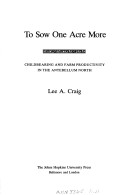Johns Hopkins University Studies in Historical and Political Science
1 total work
Children supplied valuable labour on 19th-century American farms. But the value of that labour varied, and the children themselves represented economic costs as well as benefits. How did children affect a farmer's choices? Did bigger farms mean, in effect, bigger families? Drawing on census, wage and other data, Craig addresses such questions in offering a new econometric interpretation of productivity and fertility in the antebellum North. Craig argues that children did not provide a noteworthy advantage on the frontier, though they did in the settled but rocky-soiled Northeast. He concludes that a farmer's economic strategy depended not so much on the size of this holding or his age (and fertility), as it did on regional agricultural patterns and proximity to market. These findings contradict the now dominant view that farmers adjusted output according to the number of available labourers - including children.
Distinguishing between the Northeast and Old Northwest, Craig constructs a model that incorporates both the advantages and monetary disadvantages of child labour, and accounts for the drop in fertility in regions where opportunities for children off the farm were greater than those at home.
Distinguishing between the Northeast and Old Northwest, Craig constructs a model that incorporates both the advantages and monetary disadvantages of child labour, and accounts for the drop in fertility in regions where opportunities for children off the farm were greater than those at home.
